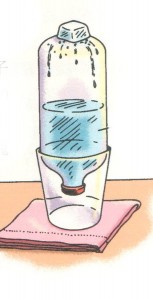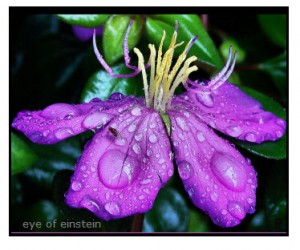Demonstrate the Water Cycle.
1. Fold a paper towel in half twice.
2. Lay the folded paper towel on a table and stand a glass on it. The glass must be large large enough to support a 16-ounce (480-ml) plastic soda or water bottle as shown.
3. Fill the bottle half full with warm tap water. Add a couple drop of blue food coloring just for fun. Close the bottle with its lid.

4. Invert the bottle and stand it in the glass.
5. Place an ice cube on top of the inverted bottle.
6. Observe the contents of the bottle as often as possible for 10 or more minutes or until the ice melts. FYI: Use another paper towel to blot any water from the melting ice if it obstructs your view of the bottle’s content.
Results
The bottle looks clear at first, then its sides look cloudy. As time passes, the tiny droplets combine forming larger drops. Some of the drops fall and others run down the inside of bottle.
Why?
Water evaporates from the surface of the warm water forming water vapor. This water vapor then condenses when it hits the top surface of the bottle or the air beneath, both of which have been cooled by the ice cube. When enough droplets have joined together, they form larger drops that fall from the inside “roof” of the bottle as well as run down the inside of the bottle. This is the same way the water cycle works on Earth.
Terms:
Vaporization is the change of a liquid to a gas. One kind of vaporization is evaporation, which occurs on the surface of liquids at a temperature below boiling point. This means that very cold liquid water can still evaporate. But the warmer is liquid water, the faster surface water molecules will evaporate.
Condensation is the process of a gas changing into a liquid. This happens when the gas is cooled.
The evaporation of water from Earth and the return of that water either in solid or liquid form is called the water cycle.
To discover how evaporation acts as a cooling system for your body, see SWEATY in

